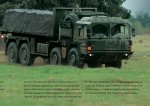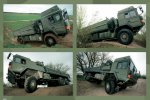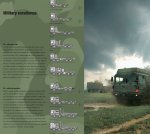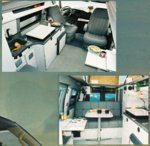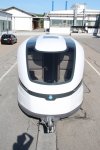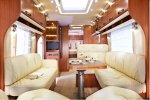biotect
Designer
...
Dear potential thread participant,
The original title of this thread was "Fully Integrated MAN or TATRA 6x6 or 8x8 Expedition RV, w Rigid, Torsion-Free Frame", but it has since evolved into something rather different. Over the course of roughly 200 pages, it has become a thread developing the concept of the "TerraLiner": a large, globally capable motorhome roughly equivalent to an American Class-A, but one that can travel bad-roads and occasionally off-road, and camp on land rented from farmers. Maximal autonomy in terms of solar, water, and sewage have become leading priorities. And following the Class-A style of motor-homing as developed in the United States by retired, wealthy couples, the TerraLiner is now being conceived as more of a 'base camp". As per American Class-As, the TerraLiner will tow a "TOAD", a supplementary SUV for fetching groceries and exploring the surrounding countryside. Except that, because towing TOADS is not permitted in many countries, the TerraLiner's SUV will be housed in a towed trailer.
As a strong distinction emerged between the TerraLiner functioning as a base-camp for sojourning, versus the TOAD serving as the vehicle primarily used for exploring, size no longer seemed such a constraining issue. So the TerraLiner is now 12 m. Although the TerraLiner is being designed to travel bad roads, and do a bit of off-roading in order to access farmer's fields where it will camp, the TerraLiner is not intended to travel narrow fire roads, forest trails, and such like. And it is absolutely not designed to rock crawl. Instead, exploring is the mission-profile of the TerraLiner's TOAD SUV. Furthermore, as it became clear that maximal power autonomy would require somehow tripling the available area of solar coverage on the TerraLiner's roof, it also became apparent that drop-down decks with integral, very robust and wind-resistant pergola frames were the solution, pergola frames carrying awnings covered with thin-film flexible solar panels. So logistical and engineering considerations almost "naturally" propelled the TerraLiner in a design direction more reminiscent of a mobile beach house, one with expansive decks.
What is emerging is a crossover vehicle of sorts, a cross between an American luxury Class-A, a mobile beach house, and an expedition motorhome based on a 6x6 AWD chassis. The TerraLiner will have elements resembling all of these, but the combined sum total will resemble none of them. Hence "Expedition RV" has been removed from the title of the thread, because it is misleading, and tends to conjure up images of a mid-sized motorhome that strikes a compromise between sojourning and exploring. The TerraLiner strikes no such compromise, and instead deliberately separates sojourning (the TerraLiner) from exploring (the TOAD SUV).
Finally, for various reasons it has come to seem important that the TerraLiner should have a hybrid drivetrain, and this thread spends a great deal of time discussing hybrid technologies for larger vehicles like buses and trucks.
"MAN" and "Tatra" have been removed from the thread's title, because they no longer seem necessary. So too "Fully Integrated" has been omitted, because the debate on that is over. Most current regular participants now recognize the superiority of a fully integrated camper interior. Finally, "Rigid Torsion Free Frame" has also been omitted, because that debate on that is over too. The TerraLiner's rigid base-chassis, in concert with the tubular-space-frame of its camper body, will function together to provide maximum rigidity.
The new title is not perfect, but it more nearly captures where the thread is now headed, and current concerns.
Please note: although this thread explores "blue sky" design, and although it becomes highly speculative in places, the goal here is to conceive a vehicle that might be built circa 2020. In other words, a vehicle that is "innovative", but not Sci-Fi; a vehicle that might be built using technology that already exists, technology that is reasonably proven. The TerraLiner will be innovative primarily in how it combines existing technology to create a new kind of vehicle: a globally capable motorhome/mobile beach house that better meets the logistical needs, preferences, and priorities of active and adventurous retired couples who are wealthy, couples who want to "slow travel" the world.
Welcome, and I hope you participate!
All best wishes,
Biotect
November 2015
********************************************
Fully Integrated 6x6 or 8x8 Expedition Vehicle,
with Rigid Frame and Progressive Coil Suspension
********************************************
1. The Purpose of this Thread
This thread explores the possibility of a different kind of very large, 6x6 or 8x8 off-road expedition vehicle: a “fully integrated” design in which the cab fuses seamlessly with the camper body.
For a rough idea of what this thread has in mind, see the following images, found on http://forum.bernard.debucquoi.com/viewtopic.php?f=11&t=4833&start=60 and http://www.offroad-forum.de/viewtopic.php?t=34729&sid=91a66bb976992decba7125d6f2458c30 :



This is a vehicle that was first described by egn, in "pivoting frames and mounting campers" at http://www.expeditionportal.com/for...es-and-mounting-campers?highlight=pivot+frame , as follows:
These very evocative images suggest at least one possible solution to the design and engineering problem that this thread wants to explore.
*****************************
2. Fully Integrated Motorhomes
In the world of mainstream RV’s, most large motorhomes are either “semi-integrated” or “fully integrated”. For some excellent overviews of mainstream market possibilities, see http://en.wikipedia.org/wiki/Motorhome , http://www.motorcaravanning.com/vehicles/basics_types.htm , and http://www.camprest.com/en/caravanning-basics/motorhomes/types-of-motorhomes .
The last link provides a wealth of interior images that make it clear why fully integrated designs are highly desirable. Even very large motorhomes can benefit from space-saving designs that make “each fitting perform more than one task, like the dining area that turns into a bed.” In particular, even the largest, mainstream European motorhomes will be fully integrated designs in which the driver and passenger seat swivel around, in order to do double-duty as dinette seating:




It's also worth noting that high-end, bespoke American motorhomes made by luxury coach manufacturers such as Liberty, Marathon, Featherlite, and Millennium, could also be considered “fully integrated”, and are usually based on a Prevost bus chassis – see http://motorhome.prevostcar.com/section/product , http://motorhome.prevostcar.com/product/models , http://motorhome.prevostcar.com/where-buy , http://www.libertycoach.com , http://www.marathoncoach.com , http://www.millenniumluxurycoaches.com , and http://www.featherlitecoaches.com . The only exception is the American market-leader in bespoke luxury coaches, Newell, which custom-builds its own, bus-like chassis. But again, Newell’s design is fully integrated – see http://www.newellcoach.com/the-coaches/photo-gallery/ and http://www.newellcoach.com/newell-coaches/coach-1508/ .
So too, in the European market for high-end, bespoke luxury motorhomes, a fabricator like Ketterer will try as far as possible to integrate the truck cab of a Merecedes-Actros, MAN, or Scania chassis, with the overall camper body – see http://www.ketterer-trucks.de/en/models.html , http://www.ketterer-trucks.de/en/models/category/c/equestrian.html , http://www.ketterer-trucks.de/en/models/category/c/travel-motorhomes/model/continental-11250-2.html , http://www.ketterer-trucks.de/en/models/category/c/travel-motorhomes/model/continental-12000-2.html , http://www.ketterer-trucks.de/en/mo...torhomes/model/continental-custom-line-2.html , http://www.ketterer-trucks.de/en/models/category/c/sports-business.html , and http://www.ketterer-trucks.de/en/trucks-in-stock/category/vehicle/ride.html . Like other large European motorhomes, two of the seats in Ketterer's cab will usually swivel, integrating with the camper seating area:

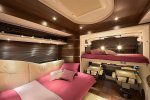
Notice how a pull-down bed is located in the cab. This bed pulls down over cab seats that fold, and it integrates beautifully with the rest of the motorhome.
Ketterer needs to come up with such "double duty" and "triple duty" solutions, because Ketter's RVs often combine a horse-box with a motorhome, with roughly half the available length allocated to the horses. So the remaining length available for human occupation has to be used very efficiently. Fully integrated designs make such space-efficient solutions much more feasible.
So the question that animates this thread is quite simple:
Why are high-end, 6x6 or 8x8 expedition vehicles almost never “fully integrated”?
*****************************
3. Non-Integrated Expedition Motorhomes
Almost all of the designs provided by fabricators of expedition-class motorhomes such as ActionMobil, UniCat, and Armadillo, are best described as “non-integrated”, in so far as they typically involve placing a separate camper body on top of a previously existing truck chassis, with a flexible “tunnel” connecting the cab to the camper – see:
(1) ActionMobil, at http://actionmobil.com/en/ , http://actionmobil.com/en/3-axle , http://actionmobil.com/en/4-axle , http://actionmobil.com/en/4-axle/specials , http://www.youtube.com/watch?v=ceFF93HV974 , and https://www.youtube.com/watch?v=M7ljGd2DXUQ .
Some videos:
(2) UniCat, at http://www.unicat.com , http://www.unicat.com/ua-en/individual.php , http://www.unicat.com/ua-en/special.php , http://www.unicat.com/ua-en/info/MXXL24AH.php , http://www.unicat.com/ua-en/pics/MXXL24AH-2.php , http://www.unicat.com/ua-en/pics/MXXL24AH-3.php , http://www.unicat.com/ua-en/pics/MXXL24AH-4.php , http://www.unicat.com/pdf/UNICAT-MXXL24AH-MAN8x8-en-es.pdf , http://www.unicat.net/en/info/EX70HDQ-MANTGA6x6.php , http://www.unicat.net/en/pics/EX70HDQ-MANTGA6x6-2.php , http://www.unicat.net/en/info/EX63HDSC-MANTGA6x6.php , http://www.unicat.net/en/pics/EX63HDSC-MANTGA6x6-2.php , http://www.unicat.net/en/info/EX70HD2M-MANTGA6x6.php , http://www.unicat.net/en/pics/EX70HD2M-MANTGA6x6-2.php , http://www.unicat.net/en/info/EX63HDM-MANTGA6x6.php , http://www.unicat.net/en/pics/EX63HDM-MANTGA6x6-2.php , http://www.unicat.net/en/info/EX58HD-MANTGA4x4.php , http://www.unicat.net/en/info/EX58HD-MANTGA4x4.php , http://www.unicat.net/en/info/EX45HD-UnimogU5000.php , http://money.cnn.com/video/pf/2012/11/01/pf-extreme-rv-home.cnnmoney/ , and https://www.youtube.com/watch?v=45Km1ArLbdA&NR=1 .
Some videos:
[video=youtube;6xRyBC8I6q0]http://www.youtube.com/watch?v=6xRyBC8I6q0&list=PLN4B1KqrNKVR__gQdXUzU0Ty C9G1t5yQ3[/video]
(3) Armadillo, a newer Chinese company, at http://www.armadillo-rv.com , http://www.armadillo-rv.com/Product.aspx or http://translate.googleusercontent....t.aspx&usg=ALkJrhggsDoN3MnNoJEUh-EIgFM01UIHFg , http://www.armadillo-rv.com/ProductDetail.aspx?ProductID=4 , http://www.armadillo-rv.com/ProductImageShow.aspx?ProductID=4&PhotoClassID=1 , http://www.armadillo-rv.com/ProductImageShow.aspx?ProductID=4&PhotoClassID=3 , http://www.armadillo-rv.com/ProductDetail.aspx?ProductID=7 , http://www.armadillo-rv.com/ProductImageShow.aspx?ProductID=7&PhotoClassID=1 , http://www.armadillo-rv.com/ProductImageShow.aspx?ProductID=7&PhotoClassID=3 , http://www.armadillo-rv.com/ProductDetail.aspx?ProductID=22 , http://www.armadillo-rv.com/ProductImageShow.aspx?ProductID=22&PhotoClassID=1 , http://www.armadillo-rv.com/ProductImageShow.aspx?ProductID=22&PhotoClassID=3 , http://www.armadillo-rv.com/ProductDetail.aspx?ProductID=18 , http://www.armadillo-rv.com/ProductImageShow.aspx?ProductID=18&PhotoClassID=1 , http://www.armadillo-rv.com/ProductImageShow.aspx?ProductID=18&PhotoClassID=3 or http://translate.googleusercontent....tID=18&usg=ALkJrhidd0y_mOes-sMSggoNvbYNK-_Sww , http://www.armadillo-rv.com/Video.aspx?SmallClassID=13 , http://www.armadillo-rv.com/Video.aspx?SmallClassID=17 , and http://www.armadillo-rv.com/Multimedia.aspx .
Unfortunately, "youku" videos do not yet seem to embed on the Expedition Portal. But here are links to two Armadillo videos: http://v.youku.com/v_show/id_XMjc5MDg1MDUy.html and http://v.youku.com/v_show/id_XMjY5NTI4NjQ0.html .
There are many more expedition RV fabricators, but the above three seem to have the most experience creating very large, 6x6 and 8x8 expedition motorhomes. For a reasonably good list of European expedition-motorhome fabricators, see http://www.kctechnik.de/haendler.html -- KCT seems to be the window-manufacturer of choice, used by many such fabricators. And for a fairly comprehensive list of American fabricators (GXV, Tiger, Four Wheels, Earthroamer, etc.), see http://www.examiner.com/article/the-rving-examiner-guide-to-overlanding .
Now from a design point of view, the separation of cab from camper seems space-wasteful, because at a bare minimum, it duplicates seating. In large 6x6 and 8x8 expedition motorhomes, driver and passenger seats almost never swivel around in order to do “double-duty” as dinette seating. Instead, completely separate, additional dinette seating has to be provided in the camper box.
*****************************
4. Expedition Motorhome Engineering Considerations
I first began exploring this question in the thread titled “pivoting frames and mounting campers”, because the answer to this question is partly a matter of engineering -- see http://www.expeditionportal.com/for...mounting-campers/page33?highlight=pivot+frame , http://www.expeditionportal.com/for...mounting-campers/page34?highlight=pivot+frame , http://www.expeditionportal.com/for...mounting-campers/page35?highlight=pivot+frame , and http://www.expeditionportal.com/for...mounting-campers/page36?highlight=pivot+frame .
When fully integrated, “mainstream” motorhomes try to travel in the Third World, over bad roads full of deep ruts and potholes, the stress created by such driving soon destroys their chassis frames and camper bodies.
Expedition motorhomes purpose-built for Third World travel overcome this problem, first, by choosing a chassis that is designed for bad-road or off-road travel. These are typically either:
(1) A Mercedes Unimog, a purpose-built off-road utility vehicle – see http://en.wikipedia.org/wiki/Unimog , http://www2.mercedes-benz.co.uk/con...imog_overview/models/u_300_-_u_500.flash.html , http://www2.mercedes-benz.co.uk/con...w/models/u_3000_-_u_5000.flash.html#chapter=1 , http://www2.mercedes-benz.co.uk/con...imog/home/unimog_overview/expertise.0002.html , http://www2.mercedes-benz.co.uk/con...Unimog/home/unimog_world/unimog_magazine.html , http://www2.mercedes-benz.co.uk/con.../Unimog/home/unimog_world/unimog_history.html , and http://www2.mercedes-benz.co.uk/con...nimog_overview/applications/construction.html .
(2) A Mercedes Zetros, a medium-size, purpose-built off-road truck – see http://en.wikipedia.org/wiki/Mercedes-Benz_Zetros , https://www.mercedes-benz-media.co.uk/commercial/model/144/Zetros , http://www.special-trucks.eu/webspecial_mercedes-benz_zetros/en/ , http://www.special-trucks.eu/webspecial_zetros/ , http://www2.mercedes-benz.co.uk/con...ochure.object.Single.File.tmp/Zetros 2011.pdf , http://www.pchristensen.dk/Files/Filer/pc/brochure/Zetros-Construction-Brochure.pdf , http://www.tradingeurope.at/Downloads/Zetros_engl.pdf , http://www.special-trucks.eu/webspecial_mercedes-benz_zetros/en/technische_daten_en.pdf , http://www.mb-military-vehicles.com/fileadmin/downloads/ZETROS Armoured.pdf .
(3) A MAN TGA (older) or MAN TGS (newer), a very large, purpose-built off-road construction truck – see http://www.mantruckandbus.hu/man/media/migrated/doc/mn_hu_1/TGS_broura.pdf , http://www.truck.man.eu/global/en/b...-duty-transport/tgs-ww/overview/Overview.html , http://www.mantruckandbus.com/man/media/migrated/doc/master_1/Construction_site_vehicles__en_.pdf , http://www.man-bodybuilder.co.uk/specs/pdf/tgs/TGS 8x4 Heavy Duty Tipper.pdf , http://www.euro6ready.com/assets/pdf/TGS/TGS_8x4_Heavy Duty Tipper_Sept_2013.pdf , http://atstrucks.co.nz/uploads/specs/TGS_8x8Tipper.pdf , and http://www.man.com.au/truck-range/tgs-range/tgs-8x8-2 .
(4) A military off-road truck converted for civilian use, such as the MAN KAT A1, the Oshkosh ARFF (Aircraft Rescue and Fire-Fighting vehicle), the Oshkosh Hemtt, or even a Tatra 815 – see http://www.expeditionportal.com/forum/threads/11614-MAN-6x6-camper?highlight=man+kat+egn , http://www.rv.net/forum/index.cfm/fuseaction/thread/tid/20933867.cfm , http://www.actionmobil.com/4-achser/desert-challenger , http://www.examiner.com/article/action-mobil-desert-challenger-the-world-s-best-off-road-rv , http://en.wikipedia.org/wiki/MAN_KAT1 , http://www.military-today.com/trucks/man_kat1_8x8.htm , http://www.scribd.com/doc/17296072/The-Mobility-Elite , http://www.rheinmetall-defence.com/en/rheinmetall_defence/index.php , and http://www.rheinmetall-defence.com/...cts/vehicle_systems/military_trucks/index.php ; http://www.expeditionportal.com/forum/threads/112015-8x8-HEMTT-Expedition-Vehicle-w-Garage , http://www.expeditionportal.com/for...-Define-America-Project?highlight=man+kat+egn , http://www.expeditionportal.com/forum/threads/11289-Oshkosh-Military-6x6-firetruck , http://www.gizmag.com/go/3708/ , http://www.oshkoshcorporation.com/brands/index.html , http://www.oshkoshairport.com/en/ARFFTrucks.aspx , http://oshkoshdefense.com , http://oshkoshdefense.com/vehicles/hemtt-a3-diesel-electric/ , http://oshkoshdefense.com/vehicles/hemtt-a4/ , http://oshkoshdefense.com/vehicles/p-19r/ , and http://www.oshkoshdefense.co.uk/wp-content/uploads/2013/09/EN-UK_OshDefOverview_Bro_6-3-2011.pdf ; http://www.theoverlander.org/my-wheels/trucks/tatra-815-2-6x6-expedition-truck.html , http://ergracing.com/tag/ctis/ , http://bangshift.com/general-news/c...rv-1985-tatra-t-815-czech-built-military-8x8/ , http://www.offroadexpress.co.nz/Forums/viewtopic.php?f=38&t=36480 , http://en.wikipedia.org/wiki/Tatra_(company) , http://www.tatratrucks.com , http://www.tatratrucks.com/trucks/customer-segment-catalog/defence/ , http://www.tatratrucks.com/trucks/c...ity-heavy-duty-universal-cargo-troop-carrier/ , and http://www.tatratrucks.com/trucks/c...ce/more-trucks/6x6-cargo-truck-troop-carrier/ .
Here too additional possibilities exist, for instance, some have used a Mercedes Actros chassis as the basis for an expedition motorhome. But in almost all cases, expedition fabricators simply mount a camper body on top of a pre-given chassis + cab.
Now the chassis is usually designed to “flex”, to absorb extreme terrain irregularities by twisting in response. Of course, the suspension system (e.g. leaf spring or coil suspension) absorbs smaller irregularities, but the twisting chassis handles the really big ones. And in so doing, it allows the vehicle to keep all 6 or 8 wheels firmly in contact with the ground. One of the very best images illustrating this basic idea, can be found on Rob Gray's "Wothahellizat Mk 1" website at http://robgray.com/graynomad/wothahellizat/wot1/index.php :

This sort of structural solution then means that the camper body has to be mounted on a separate “sub-frame”, a sub-frame that “floats” or pivots above the main chassis, as pictured above. The camper body has to be rigid (obviously), and cannot twist like the underlying chassis frame. So the main purpose of the sub-frame is to structurally isolate the camper body from the twisting chassis frame, and needless to say, to also isolate it from the stress that the chassis frame absorbs when travelling over bad roads or off-road. Different ideas exist about how this might best be accomplished, for instance, whether a “4-point pivoting sub-frame” is superior to a “3-point pivoting sub-frame”. To my knowledge, by far the best web-discussion of the alternatives is the “pivoting frames and mounting campers” thread here on the Expedition Portal, already mentioned, at http://www.expeditionportal.com/for...es-and-mounting-campers?highlight=pivot+frame .
If you check out the videos on the Armadillo and ActionMobil website, videos of big 6x6 or 8x8 expedition vehicles handling difficult terrain, you will see that the cab often goes in one direction, and the camper body in another -- see http://www.actionmobil.com/home/videos and http://www.armadillo-rv.com/Multimedia.aspx . Again, that’s because the underlying chassis frame has been deliberately designed to twist, with the camper body isolated from that stress by the pivoting sub-frame. For a good video playlist of "Expedition Trucks and Campers", also see http://shelf3d.com/Search/Expedition+Trucks+and+Campers+PlayListIDPLEDEADF4587B99C71 .
The overall consequence, from a design point of view, would seem to be that large expedition motorhomes cannot be fully integrated, because the cab and camper body have to be mounted on separate pivoting frames. The newest Zetros truck, for instance, comes with its cab mounted on a 3-point pivoting frame – see the technical literature at https://www.mercedes-benz-media.co.uk/commercial/model/144/Zetros .
So the answer to the design-question, “Why are high-end, 6x6 or 8x8 expedition vehicles almost never “fully integrated?”, seems to be the engineering response: “Because the cab and the camper have to be mounted on separate, pivoting sub-frames that structurally isolate them from each other, and from an underlying chassis that twists.”
I am not certain whether this is the whole story, however. In “pivoting frames and mounting campers”, Iain_U1250 posted some interesting pictures of a Unimog camper that has a single, unified, "fully integrated" body. Apparently lots of similar uni-body Unimog campers were built in the 1990's -- see http://www.expeditionportal.com/for...mounting-campers/page33?highlight=pivot+frame. Now the Unimog chassis is deliberately designed to twist. So if a fully integrated design is possible with a Unimog chassis, then in theory at least, it should be possible with just about any chassis.
Still, this is just speculation on my part, and those with engineering backgrounds would be better able to asses the plausibility of this conjecture.
*****************************
5. MAN and Tatra Trucks with Rigid, Torsion-Free Frames and Progressive Coil Suspensions
This thread, then, begins with the more conservative working assumption that, in order to successfully mount a fully integrated, unibody camper on top of an expedition-grade chassis, that chassis has to be completely rigid, and cannot twist.
Is such a thing possible? Does an off-road truck chassis have to twist?
Again, the chassis of a Unimog, the most extreme-terrain-capable vehicle in the world, which can handle rock-crawling (for instance), is deliberately designed to twist. So the answer to this question would seem to be , “Yes, an off-road truck chassis should twist.” And so pivoting sub-frames are necessary, and a fully integrated, large, off-road expedition vehicle is a design impossibility.
That’s the conventional wisdom, and it’s the perspective that seems to dominate discussion in the “pivoting frames and mounting campers” thread.
But what if it’s not true? What if there exist examples of off-road trucks that have completely rigid, torsion-free box-frames; trucks in which a progressive coil suspension absorbs all terrain irregularities?
In fact, Rheinmetall-MAN military does make such trucks, in its SX-series, as does Tatra, in its 815 series – see http://www.scribd.com/doc/17296072/The-Mobility-Elite , http://www.rheinmetall-defence.de/e...s/rheinmetall_man_military_vehicles/index.php , http://www.tatratrucks.com/trucks/c...ity-heavy-duty-universal-cargo-troop-carrier/ . For an excellent video of such a truck in action, provided by egn, see the following, and notice how the cab and body remain completely fixed with respect to each other. Here the underlying chassis frame quite evidently does not twist:
I don't know whether other manufacturers of military-grade trucks, such as Mercedes and Oshkosh, also make "extreme mobility" trucks similar to the Rheinmetall-MAN SX-45, trucks that have rigid, torsion-free frames combined with progressive coil suspensions. Hopefully that's one of the questions that will be answered at some point, as this thread gets underway.
So the question of this thread becomes:
Can the military technology of torsion-free chassis frames coupled with progressive coil suspension, be adapted to civilian use, to serve as the engineering foundation for large, fully integrated, 6x6 or 8x8 expedition-style motorhomes? Can it be done cost-effectively?
That’s the main question that this thread will explore, at lest initially. But the overall design-goal is a fully integrated 6x6 or 8x8 expedition-style motorhome, and not any particular engineering solution.
*****************************
6. Pivoting Frames and Mounting Campers
Now again, it needs to be emphasized that some of the key ideas and arguments that animate this thread were first posted elsewhere, namely, on pages 34, 35, 36, and 37 of “pivoting frames and mounting campers” – again, see http://www.expeditionportal.com/forum/threads/25494-pivoting-frames-and-mounting-campers/page33 , http://www.expeditionportal.com/forum/threads/25494-pivoting-frames-and-mounting-campers/page34 , http://www.expeditionportal.com/forum/threads/25494-pivoting-frames-and-mounting-campers/page35 , and http://www.expeditionportal.com/forum/threads/25494-pivoting-frames-and-mounting-campers/page36 .
So if you are a newcomer, to develop a full understanding of the issues it might be wise to read those pages first, before continuing here. However, in the next few posts I will try to re-post much of that material. And I would request that, if they have time available, egn, moe, Iain_U1250, and others might want to do likewise.
All best wishes,
Biotect
Dear potential thread participant,
The original title of this thread was "Fully Integrated MAN or TATRA 6x6 or 8x8 Expedition RV, w Rigid, Torsion-Free Frame", but it has since evolved into something rather different. Over the course of roughly 200 pages, it has become a thread developing the concept of the "TerraLiner": a large, globally capable motorhome roughly equivalent to an American Class-A, but one that can travel bad-roads and occasionally off-road, and camp on land rented from farmers. Maximal autonomy in terms of solar, water, and sewage have become leading priorities. And following the Class-A style of motor-homing as developed in the United States by retired, wealthy couples, the TerraLiner is now being conceived as more of a 'base camp". As per American Class-As, the TerraLiner will tow a "TOAD", a supplementary SUV for fetching groceries and exploring the surrounding countryside. Except that, because towing TOADS is not permitted in many countries, the TerraLiner's SUV will be housed in a towed trailer.
As a strong distinction emerged between the TerraLiner functioning as a base-camp for sojourning, versus the TOAD serving as the vehicle primarily used for exploring, size no longer seemed such a constraining issue. So the TerraLiner is now 12 m. Although the TerraLiner is being designed to travel bad roads, and do a bit of off-roading in order to access farmer's fields where it will camp, the TerraLiner is not intended to travel narrow fire roads, forest trails, and such like. And it is absolutely not designed to rock crawl. Instead, exploring is the mission-profile of the TerraLiner's TOAD SUV. Furthermore, as it became clear that maximal power autonomy would require somehow tripling the available area of solar coverage on the TerraLiner's roof, it also became apparent that drop-down decks with integral, very robust and wind-resistant pergola frames were the solution, pergola frames carrying awnings covered with thin-film flexible solar panels. So logistical and engineering considerations almost "naturally" propelled the TerraLiner in a design direction more reminiscent of a mobile beach house, one with expansive decks.
What is emerging is a crossover vehicle of sorts, a cross between an American luxury Class-A, a mobile beach house, and an expedition motorhome based on a 6x6 AWD chassis. The TerraLiner will have elements resembling all of these, but the combined sum total will resemble none of them. Hence "Expedition RV" has been removed from the title of the thread, because it is misleading, and tends to conjure up images of a mid-sized motorhome that strikes a compromise between sojourning and exploring. The TerraLiner strikes no such compromise, and instead deliberately separates sojourning (the TerraLiner) from exploring (the TOAD SUV).
Finally, for various reasons it has come to seem important that the TerraLiner should have a hybrid drivetrain, and this thread spends a great deal of time discussing hybrid technologies for larger vehicles like buses and trucks.
"MAN" and "Tatra" have been removed from the thread's title, because they no longer seem necessary. So too "Fully Integrated" has been omitted, because the debate on that is over. Most current regular participants now recognize the superiority of a fully integrated camper interior. Finally, "Rigid Torsion Free Frame" has also been omitted, because that debate on that is over too. The TerraLiner's rigid base-chassis, in concert with the tubular-space-frame of its camper body, will function together to provide maximum rigidity.
The new title is not perfect, but it more nearly captures where the thread is now headed, and current concerns.
Please note: although this thread explores "blue sky" design, and although it becomes highly speculative in places, the goal here is to conceive a vehicle that might be built circa 2020. In other words, a vehicle that is "innovative", but not Sci-Fi; a vehicle that might be built using technology that already exists, technology that is reasonably proven. The TerraLiner will be innovative primarily in how it combines existing technology to create a new kind of vehicle: a globally capable motorhome/mobile beach house that better meets the logistical needs, preferences, and priorities of active and adventurous retired couples who are wealthy, couples who want to "slow travel" the world.
Welcome, and I hope you participate!
All best wishes,
Biotect
November 2015
********************************************
Fully Integrated 6x6 or 8x8 Expedition Vehicle,
with Rigid Frame and Progressive Coil Suspension
********************************************
1. The Purpose of this Thread
This thread explores the possibility of a different kind of very large, 6x6 or 8x8 off-road expedition vehicle: a “fully integrated” design in which the cab fuses seamlessly with the camper body.
For a rough idea of what this thread has in mind, see the following images, found on http://forum.bernard.debucquoi.com/viewtopic.php?f=11&t=4833&start=60 and http://www.offroad-forum.de/viewtopic.php?t=34729&sid=91a66bb976992decba7125d6f2458c30 :



This is a vehicle that was first described by egn, in "pivoting frames and mounting campers" at http://www.expeditionportal.com/for...es-and-mounting-campers?highlight=pivot+frame , as follows:
-- see http://www.expeditionportal.com/for...mounting-campers/page35?highlight=pivot+frame .I looked through my large collection of truck images, especially the KAT ones, and found the build of an integrated camper. When you get the KAT book on page 118 you will see an image of it. It was build by Unicat based on the Austrian version of the KAT…. The silhouette of the cab is just extended to the back.
These very evocative images suggest at least one possible solution to the design and engineering problem that this thread wants to explore.
*****************************
2. Fully Integrated Motorhomes
In the world of mainstream RV’s, most large motorhomes are either “semi-integrated” or “fully integrated”. For some excellent overviews of mainstream market possibilities, see http://en.wikipedia.org/wiki/Motorhome , http://www.motorcaravanning.com/vehicles/basics_types.htm , and http://www.camprest.com/en/caravanning-basics/motorhomes/types-of-motorhomes .
The last link provides a wealth of interior images that make it clear why fully integrated designs are highly desirable. Even very large motorhomes can benefit from space-saving designs that make “each fitting perform more than one task, like the dining area that turns into a bed.” In particular, even the largest, mainstream European motorhomes will be fully integrated designs in which the driver and passenger seat swivel around, in order to do double-duty as dinette seating:




It's also worth noting that high-end, bespoke American motorhomes made by luxury coach manufacturers such as Liberty, Marathon, Featherlite, and Millennium, could also be considered “fully integrated”, and are usually based on a Prevost bus chassis – see http://motorhome.prevostcar.com/section/product , http://motorhome.prevostcar.com/product/models , http://motorhome.prevostcar.com/where-buy , http://www.libertycoach.com , http://www.marathoncoach.com , http://www.millenniumluxurycoaches.com , and http://www.featherlitecoaches.com . The only exception is the American market-leader in bespoke luxury coaches, Newell, which custom-builds its own, bus-like chassis. But again, Newell’s design is fully integrated – see http://www.newellcoach.com/the-coaches/photo-gallery/ and http://www.newellcoach.com/newell-coaches/coach-1508/ .
So too, in the European market for high-end, bespoke luxury motorhomes, a fabricator like Ketterer will try as far as possible to integrate the truck cab of a Merecedes-Actros, MAN, or Scania chassis, with the overall camper body – see http://www.ketterer-trucks.de/en/models.html , http://www.ketterer-trucks.de/en/models/category/c/equestrian.html , http://www.ketterer-trucks.de/en/models/category/c/travel-motorhomes/model/continental-11250-2.html , http://www.ketterer-trucks.de/en/models/category/c/travel-motorhomes/model/continental-12000-2.html , http://www.ketterer-trucks.de/en/mo...torhomes/model/continental-custom-line-2.html , http://www.ketterer-trucks.de/en/models/category/c/sports-business.html , and http://www.ketterer-trucks.de/en/trucks-in-stock/category/vehicle/ride.html . Like other large European motorhomes, two of the seats in Ketterer's cab will usually swivel, integrating with the camper seating area:


Notice how a pull-down bed is located in the cab. This bed pulls down over cab seats that fold, and it integrates beautifully with the rest of the motorhome.
Ketterer needs to come up with such "double duty" and "triple duty" solutions, because Ketter's RVs often combine a horse-box with a motorhome, with roughly half the available length allocated to the horses. So the remaining length available for human occupation has to be used very efficiently. Fully integrated designs make such space-efficient solutions much more feasible.
So the question that animates this thread is quite simple:
Why are high-end, 6x6 or 8x8 expedition vehicles almost never “fully integrated”?
*****************************
3. Non-Integrated Expedition Motorhomes
Almost all of the designs provided by fabricators of expedition-class motorhomes such as ActionMobil, UniCat, and Armadillo, are best described as “non-integrated”, in so far as they typically involve placing a separate camper body on top of a previously existing truck chassis, with a flexible “tunnel” connecting the cab to the camper – see:
(1) ActionMobil, at http://actionmobil.com/en/ , http://actionmobil.com/en/3-axle , http://actionmobil.com/en/4-axle , http://actionmobil.com/en/4-axle/specials , http://www.youtube.com/watch?v=ceFF93HV974 , and https://www.youtube.com/watch?v=M7ljGd2DXUQ .
Some videos:
(2) UniCat, at http://www.unicat.com , http://www.unicat.com/ua-en/individual.php , http://www.unicat.com/ua-en/special.php , http://www.unicat.com/ua-en/info/MXXL24AH.php , http://www.unicat.com/ua-en/pics/MXXL24AH-2.php , http://www.unicat.com/ua-en/pics/MXXL24AH-3.php , http://www.unicat.com/ua-en/pics/MXXL24AH-4.php , http://www.unicat.com/pdf/UNICAT-MXXL24AH-MAN8x8-en-es.pdf , http://www.unicat.net/en/info/EX70HDQ-MANTGA6x6.php , http://www.unicat.net/en/pics/EX70HDQ-MANTGA6x6-2.php , http://www.unicat.net/en/info/EX63HDSC-MANTGA6x6.php , http://www.unicat.net/en/pics/EX63HDSC-MANTGA6x6-2.php , http://www.unicat.net/en/info/EX70HD2M-MANTGA6x6.php , http://www.unicat.net/en/pics/EX70HD2M-MANTGA6x6-2.php , http://www.unicat.net/en/info/EX63HDM-MANTGA6x6.php , http://www.unicat.net/en/pics/EX63HDM-MANTGA6x6-2.php , http://www.unicat.net/en/info/EX58HD-MANTGA4x4.php , http://www.unicat.net/en/info/EX58HD-MANTGA4x4.php , http://www.unicat.net/en/info/EX45HD-UnimogU5000.php , http://money.cnn.com/video/pf/2012/11/01/pf-extreme-rv-home.cnnmoney/ , and https://www.youtube.com/watch?v=45Km1ArLbdA&NR=1 .
Some videos:
[video=youtube;6xRyBC8I6q0]http://www.youtube.com/watch?v=6xRyBC8I6q0&list=PLN4B1KqrNKVR__gQdXUzU0Ty C9G1t5yQ3[/video]
(3) Armadillo, a newer Chinese company, at http://www.armadillo-rv.com , http://www.armadillo-rv.com/Product.aspx or http://translate.googleusercontent....t.aspx&usg=ALkJrhggsDoN3MnNoJEUh-EIgFM01UIHFg , http://www.armadillo-rv.com/ProductDetail.aspx?ProductID=4 , http://www.armadillo-rv.com/ProductImageShow.aspx?ProductID=4&PhotoClassID=1 , http://www.armadillo-rv.com/ProductImageShow.aspx?ProductID=4&PhotoClassID=3 , http://www.armadillo-rv.com/ProductDetail.aspx?ProductID=7 , http://www.armadillo-rv.com/ProductImageShow.aspx?ProductID=7&PhotoClassID=1 , http://www.armadillo-rv.com/ProductImageShow.aspx?ProductID=7&PhotoClassID=3 , http://www.armadillo-rv.com/ProductDetail.aspx?ProductID=22 , http://www.armadillo-rv.com/ProductImageShow.aspx?ProductID=22&PhotoClassID=1 , http://www.armadillo-rv.com/ProductImageShow.aspx?ProductID=22&PhotoClassID=3 , http://www.armadillo-rv.com/ProductDetail.aspx?ProductID=18 , http://www.armadillo-rv.com/ProductImageShow.aspx?ProductID=18&PhotoClassID=1 , http://www.armadillo-rv.com/ProductImageShow.aspx?ProductID=18&PhotoClassID=3 or http://translate.googleusercontent....tID=18&usg=ALkJrhidd0y_mOes-sMSggoNvbYNK-_Sww , http://www.armadillo-rv.com/Video.aspx?SmallClassID=13 , http://www.armadillo-rv.com/Video.aspx?SmallClassID=17 , and http://www.armadillo-rv.com/Multimedia.aspx .
Unfortunately, "youku" videos do not yet seem to embed on the Expedition Portal. But here are links to two Armadillo videos: http://v.youku.com/v_show/id_XMjc5MDg1MDUy.html and http://v.youku.com/v_show/id_XMjY5NTI4NjQ0.html .
There are many more expedition RV fabricators, but the above three seem to have the most experience creating very large, 6x6 and 8x8 expedition motorhomes. For a reasonably good list of European expedition-motorhome fabricators, see http://www.kctechnik.de/haendler.html -- KCT seems to be the window-manufacturer of choice, used by many such fabricators. And for a fairly comprehensive list of American fabricators (GXV, Tiger, Four Wheels, Earthroamer, etc.), see http://www.examiner.com/article/the-rving-examiner-guide-to-overlanding .
Now from a design point of view, the separation of cab from camper seems space-wasteful, because at a bare minimum, it duplicates seating. In large 6x6 and 8x8 expedition motorhomes, driver and passenger seats almost never swivel around in order to do “double-duty” as dinette seating. Instead, completely separate, additional dinette seating has to be provided in the camper box.
*****************************
4. Expedition Motorhome Engineering Considerations
I first began exploring this question in the thread titled “pivoting frames and mounting campers”, because the answer to this question is partly a matter of engineering -- see http://www.expeditionportal.com/for...mounting-campers/page33?highlight=pivot+frame , http://www.expeditionportal.com/for...mounting-campers/page34?highlight=pivot+frame , http://www.expeditionportal.com/for...mounting-campers/page35?highlight=pivot+frame , and http://www.expeditionportal.com/for...mounting-campers/page36?highlight=pivot+frame .
When fully integrated, “mainstream” motorhomes try to travel in the Third World, over bad roads full of deep ruts and potholes, the stress created by such driving soon destroys their chassis frames and camper bodies.
Expedition motorhomes purpose-built for Third World travel overcome this problem, first, by choosing a chassis that is designed for bad-road or off-road travel. These are typically either:
(1) A Mercedes Unimog, a purpose-built off-road utility vehicle – see http://en.wikipedia.org/wiki/Unimog , http://www2.mercedes-benz.co.uk/con...imog_overview/models/u_300_-_u_500.flash.html , http://www2.mercedes-benz.co.uk/con...w/models/u_3000_-_u_5000.flash.html#chapter=1 , http://www2.mercedes-benz.co.uk/con...imog/home/unimog_overview/expertise.0002.html , http://www2.mercedes-benz.co.uk/con...Unimog/home/unimog_world/unimog_magazine.html , http://www2.mercedes-benz.co.uk/con.../Unimog/home/unimog_world/unimog_history.html , and http://www2.mercedes-benz.co.uk/con...nimog_overview/applications/construction.html .
(2) A Mercedes Zetros, a medium-size, purpose-built off-road truck – see http://en.wikipedia.org/wiki/Mercedes-Benz_Zetros , https://www.mercedes-benz-media.co.uk/commercial/model/144/Zetros , http://www.special-trucks.eu/webspecial_mercedes-benz_zetros/en/ , http://www.special-trucks.eu/webspecial_zetros/ , http://www2.mercedes-benz.co.uk/con...ochure.object.Single.File.tmp/Zetros 2011.pdf , http://www.pchristensen.dk/Files/Filer/pc/brochure/Zetros-Construction-Brochure.pdf , http://www.tradingeurope.at/Downloads/Zetros_engl.pdf , http://www.special-trucks.eu/webspecial_mercedes-benz_zetros/en/technische_daten_en.pdf , http://www.mb-military-vehicles.com/fileadmin/downloads/ZETROS Armoured.pdf .
(3) A MAN TGA (older) or MAN TGS (newer), a very large, purpose-built off-road construction truck – see http://www.mantruckandbus.hu/man/media/migrated/doc/mn_hu_1/TGS_broura.pdf , http://www.truck.man.eu/global/en/b...-duty-transport/tgs-ww/overview/Overview.html , http://www.mantruckandbus.com/man/media/migrated/doc/master_1/Construction_site_vehicles__en_.pdf , http://www.man-bodybuilder.co.uk/specs/pdf/tgs/TGS 8x4 Heavy Duty Tipper.pdf , http://www.euro6ready.com/assets/pdf/TGS/TGS_8x4_Heavy Duty Tipper_Sept_2013.pdf , http://atstrucks.co.nz/uploads/specs/TGS_8x8Tipper.pdf , and http://www.man.com.au/truck-range/tgs-range/tgs-8x8-2 .
(4) A military off-road truck converted for civilian use, such as the MAN KAT A1, the Oshkosh ARFF (Aircraft Rescue and Fire-Fighting vehicle), the Oshkosh Hemtt, or even a Tatra 815 – see http://www.expeditionportal.com/forum/threads/11614-MAN-6x6-camper?highlight=man+kat+egn , http://www.rv.net/forum/index.cfm/fuseaction/thread/tid/20933867.cfm , http://www.actionmobil.com/4-achser/desert-challenger , http://www.examiner.com/article/action-mobil-desert-challenger-the-world-s-best-off-road-rv , http://en.wikipedia.org/wiki/MAN_KAT1 , http://www.military-today.com/trucks/man_kat1_8x8.htm , http://www.scribd.com/doc/17296072/The-Mobility-Elite , http://www.rheinmetall-defence.com/en/rheinmetall_defence/index.php , and http://www.rheinmetall-defence.com/...cts/vehicle_systems/military_trucks/index.php ; http://www.expeditionportal.com/forum/threads/112015-8x8-HEMTT-Expedition-Vehicle-w-Garage , http://www.expeditionportal.com/for...-Define-America-Project?highlight=man+kat+egn , http://www.expeditionportal.com/forum/threads/11289-Oshkosh-Military-6x6-firetruck , http://www.gizmag.com/go/3708/ , http://www.oshkoshcorporation.com/brands/index.html , http://www.oshkoshairport.com/en/ARFFTrucks.aspx , http://oshkoshdefense.com , http://oshkoshdefense.com/vehicles/hemtt-a3-diesel-electric/ , http://oshkoshdefense.com/vehicles/hemtt-a4/ , http://oshkoshdefense.com/vehicles/p-19r/ , and http://www.oshkoshdefense.co.uk/wp-content/uploads/2013/09/EN-UK_OshDefOverview_Bro_6-3-2011.pdf ; http://www.theoverlander.org/my-wheels/trucks/tatra-815-2-6x6-expedition-truck.html , http://ergracing.com/tag/ctis/ , http://bangshift.com/general-news/c...rv-1985-tatra-t-815-czech-built-military-8x8/ , http://www.offroadexpress.co.nz/Forums/viewtopic.php?f=38&t=36480 , http://en.wikipedia.org/wiki/Tatra_(company) , http://www.tatratrucks.com , http://www.tatratrucks.com/trucks/customer-segment-catalog/defence/ , http://www.tatratrucks.com/trucks/c...ity-heavy-duty-universal-cargo-troop-carrier/ , and http://www.tatratrucks.com/trucks/c...ce/more-trucks/6x6-cargo-truck-troop-carrier/ .
Here too additional possibilities exist, for instance, some have used a Mercedes Actros chassis as the basis for an expedition motorhome. But in almost all cases, expedition fabricators simply mount a camper body on top of a pre-given chassis + cab.
Now the chassis is usually designed to “flex”, to absorb extreme terrain irregularities by twisting in response. Of course, the suspension system (e.g. leaf spring or coil suspension) absorbs smaller irregularities, but the twisting chassis handles the really big ones. And in so doing, it allows the vehicle to keep all 6 or 8 wheels firmly in contact with the ground. One of the very best images illustrating this basic idea, can be found on Rob Gray's "Wothahellizat Mk 1" website at http://robgray.com/graynomad/wothahellizat/wot1/index.php :

This sort of structural solution then means that the camper body has to be mounted on a separate “sub-frame”, a sub-frame that “floats” or pivots above the main chassis, as pictured above. The camper body has to be rigid (obviously), and cannot twist like the underlying chassis frame. So the main purpose of the sub-frame is to structurally isolate the camper body from the twisting chassis frame, and needless to say, to also isolate it from the stress that the chassis frame absorbs when travelling over bad roads or off-road. Different ideas exist about how this might best be accomplished, for instance, whether a “4-point pivoting sub-frame” is superior to a “3-point pivoting sub-frame”. To my knowledge, by far the best web-discussion of the alternatives is the “pivoting frames and mounting campers” thread here on the Expedition Portal, already mentioned, at http://www.expeditionportal.com/for...es-and-mounting-campers?highlight=pivot+frame .
If you check out the videos on the Armadillo and ActionMobil website, videos of big 6x6 or 8x8 expedition vehicles handling difficult terrain, you will see that the cab often goes in one direction, and the camper body in another -- see http://www.actionmobil.com/home/videos and http://www.armadillo-rv.com/Multimedia.aspx . Again, that’s because the underlying chassis frame has been deliberately designed to twist, with the camper body isolated from that stress by the pivoting sub-frame. For a good video playlist of "Expedition Trucks and Campers", also see http://shelf3d.com/Search/Expedition+Trucks+and+Campers+PlayListIDPLEDEADF4587B99C71 .
The overall consequence, from a design point of view, would seem to be that large expedition motorhomes cannot be fully integrated, because the cab and camper body have to be mounted on separate pivoting frames. The newest Zetros truck, for instance, comes with its cab mounted on a 3-point pivoting frame – see the technical literature at https://www.mercedes-benz-media.co.uk/commercial/model/144/Zetros .
So the answer to the design-question, “Why are high-end, 6x6 or 8x8 expedition vehicles almost never “fully integrated?”, seems to be the engineering response: “Because the cab and the camper have to be mounted on separate, pivoting sub-frames that structurally isolate them from each other, and from an underlying chassis that twists.”
I am not certain whether this is the whole story, however. In “pivoting frames and mounting campers”, Iain_U1250 posted some interesting pictures of a Unimog camper that has a single, unified, "fully integrated" body. Apparently lots of similar uni-body Unimog campers were built in the 1990's -- see http://www.expeditionportal.com/for...mounting-campers/page33?highlight=pivot+frame. Now the Unimog chassis is deliberately designed to twist. So if a fully integrated design is possible with a Unimog chassis, then in theory at least, it should be possible with just about any chassis.
Still, this is just speculation on my part, and those with engineering backgrounds would be better able to asses the plausibility of this conjecture.
*****************************
5. MAN and Tatra Trucks with Rigid, Torsion-Free Frames and Progressive Coil Suspensions
This thread, then, begins with the more conservative working assumption that, in order to successfully mount a fully integrated, unibody camper on top of an expedition-grade chassis, that chassis has to be completely rigid, and cannot twist.
Is such a thing possible? Does an off-road truck chassis have to twist?
Again, the chassis of a Unimog, the most extreme-terrain-capable vehicle in the world, which can handle rock-crawling (for instance), is deliberately designed to twist. So the answer to this question would seem to be , “Yes, an off-road truck chassis should twist.” And so pivoting sub-frames are necessary, and a fully integrated, large, off-road expedition vehicle is a design impossibility.
That’s the conventional wisdom, and it’s the perspective that seems to dominate discussion in the “pivoting frames and mounting campers” thread.
But what if it’s not true? What if there exist examples of off-road trucks that have completely rigid, torsion-free box-frames; trucks in which a progressive coil suspension absorbs all terrain irregularities?
In fact, Rheinmetall-MAN military does make such trucks, in its SX-series, as does Tatra, in its 815 series – see http://www.scribd.com/doc/17296072/The-Mobility-Elite , http://www.rheinmetall-defence.de/e...s/rheinmetall_man_military_vehicles/index.php , http://www.tatratrucks.com/trucks/c...ity-heavy-duty-universal-cargo-troop-carrier/ . For an excellent video of such a truck in action, provided by egn, see the following, and notice how the cab and body remain completely fixed with respect to each other. Here the underlying chassis frame quite evidently does not twist:
I don't know whether other manufacturers of military-grade trucks, such as Mercedes and Oshkosh, also make "extreme mobility" trucks similar to the Rheinmetall-MAN SX-45, trucks that have rigid, torsion-free frames combined with progressive coil suspensions. Hopefully that's one of the questions that will be answered at some point, as this thread gets underway.
So the question of this thread becomes:
Can the military technology of torsion-free chassis frames coupled with progressive coil suspension, be adapted to civilian use, to serve as the engineering foundation for large, fully integrated, 6x6 or 8x8 expedition-style motorhomes? Can it be done cost-effectively?
That’s the main question that this thread will explore, at lest initially. But the overall design-goal is a fully integrated 6x6 or 8x8 expedition-style motorhome, and not any particular engineering solution.
*****************************
6. Pivoting Frames and Mounting Campers
Now again, it needs to be emphasized that some of the key ideas and arguments that animate this thread were first posted elsewhere, namely, on pages 34, 35, 36, and 37 of “pivoting frames and mounting campers” – again, see http://www.expeditionportal.com/forum/threads/25494-pivoting-frames-and-mounting-campers/page33 , http://www.expeditionportal.com/forum/threads/25494-pivoting-frames-and-mounting-campers/page34 , http://www.expeditionportal.com/forum/threads/25494-pivoting-frames-and-mounting-campers/page35 , and http://www.expeditionportal.com/forum/threads/25494-pivoting-frames-and-mounting-campers/page36 .
So if you are a newcomer, to develop a full understanding of the issues it might be wise to read those pages first, before continuing here. However, in the next few posts I will try to re-post much of that material. And I would request that, if they have time available, egn, moe, Iain_U1250, and others might want to do likewise.
All best wishes,
Biotect
Last edited:




